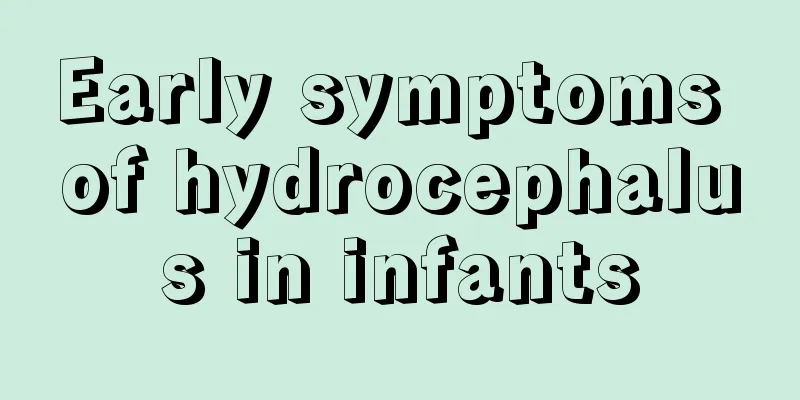Causes of high hemoglobin in newborns

|
Many parents will take their children to the hospital for examination when they find that their children are not feeling well. Through the examination, they find that their children's hemoglobin is high. This result makes many parents more suspicious, but they are more worried about what is wrong with their children's physical condition at this time. In fact, there are many reasons for high hemoglobin. Children's hemoglobin also has a normal value. If it exceeds the normal value, it means it is too high. So what is the reason for the high hemoglobin in children? A high hemoglobin concentration may be a physiological condition or a pathological condition. If you have not eaten or drunk water for a long time before the blood test, your blood will be somewhat concentrated and the test results may show high hemoglobin. Stress can also cause the same situation. If it is caused by an illness, it is often a serious heart or lung disease. The body is in a state of hypoxia for a long time, which can also cause a high hemoglobin concentration. The situation you described is probably caused by physiological reasons. Don't worry. If you drink a glass of water before the examination, the value may be lowered. Relative increase: Due to some reasons, the water in the plasma is lost, the blood is concentrated, and the content of red blood cells and hemoglobin increases relatively. Such as continuous severe vomiting, large-area burns, severe diarrhea, heavy sweating, etc.; also seen in chronic adrenal cortex insufficiency, diabetes insipidus, hyperthyroidism, etc. Absolute increase: The absolute value of red blood cells and hemoglobin in the blood increases due to various reasons, which is mostly related to the body's circulation and tissue hypoxia, increased erythropoietin levels in the blood, and accelerated release of red blood cells by the bone marrow. Physiological increase: seen in plateau residents, fetuses and newborns, intense labor, fear, cold water baths, etc. The normal value of hemoglobin should be 110-160g/L. However, for infants from 3 months old to children under 15 years old, due to their rapid growth and development, the raw materials for hematopoiesis are relatively insufficient, and their red blood cells and hemoglobin may be 10% to 20% lower than those of normal people. So your baby's blood sugar is 93g/L, and the doctor's diagnosis of mild anemia is correct. Trace element testing showed that the baby's iron level was within the normal range, but not very high. Lead poisoning in 6-month-old babies is rare and can basically be ruled out. Recommended food supplements: tomatoes, rapeseed, celery, apricots, peaches, plums, oranges, dates, lean meat, egg yolks, animal liver, kidneys, black fungus, etc. However, many friends do not know what the normal hemoglobin value is after checking their hemoglobin, which makes it impossible for them to judge their own physical condition. In order to help you understand your physical condition in detail, let’s take a look at the normal hemoglobin value here. Hemoglobin is a protein responsible for carrying oxygen in higher organisms and is the protein that makes blood red. Hemoglobin consists of four chains, two α chains and two β chains, each of which has a ring-shaped heme containing an iron atom. Oxygen is bound to iron atoms and transported in the blood. The characteristics of hemoglobin are: it easily combines with oxygen in places with high oxygen content; and it easily separates from oxygen in places with low oxygen content. This characteristic of hemoglobin enables red blood cells to transport oxygen. Hemoglobin is used in biochemical research, culture of influenza virus, gonococci, tularemia bacillus, streptococci, pneumococci, etc., and pigments. Normal parameter Adult male: 120-160 g/L Adult female: 110-150 g/L Newborn: 170-200 g/L Adolescents (children): 110-160 g/L High hemoglobin Hemoglobin is a protein responsible for transporting oxygen in higher organisms. It is mainly found in the blood of vertebrates, some invertebrates and root nodules of legumes. The normal hemoglobin value for adult males is 120-160g/L, the normal value for adult females is 110-150g/L, the normal value for newborns is 170-200g/L, and the normal value for children is 110-160g/L. There are many reasons for high hemoglobin, which can be roughly divided into physiological increase and pathological increase. Physiological increase is common in plateau residents, fetuses and newborns, strenuous exercise, heavy sweating, fear, etc.; pathological increase is common in large-area burns, severe diarrhea, chronic adrenal insufficiency, diabetes insipidus, hyperthyroidism, cardiopulmonary disease, vascular malformations and other diseases. If the child's hemoglobin is found to be high, you need to check whether the child has the conditions mentioned above. If the child has diarrhea, the hemoglobin may also be high. But in general, if the child's hemoglobin is high, the cause can be very harmful to the body. You must be clear and rule out the possibility that the child has heart or lung disease, or vascular malformations, as this will have a greater impact. |
<<: Causes of sticky stools in babies
>>: What are the medicines for children to improve immunity?
Recommend
Why is there less urine in children?
If parents find that their children urinate less,...
Diaper rash in children
A rash is a skin disease and is often a serious p...
What are the symptoms when a child is frightened?
For newborn babies, although all food is fresh an...
What are the symptoms of a mild concussion in a child?
I believe that many people should be very familia...
What should I do if my child sprains his ankle?
Children usually like to do sports very much, and...
Baby's buttocks red
If your baby has a red butt, it is likely that th...
Will children get angry if they drink milk powder?
Many children will choose to drink some breast mi...
What to do if your baby's hand is broken and bleeding
Children are usually naughty when running and jum...
What to do if a child has foreign matter in his nose
Children are relatively young, so parents must pa...
What should I apply on my baby's red butt?
Children may develop a red buttocks if their diap...
What to do if your baby is overweight
Many elderly people like their grandchildren to b...
Signs of high IQ in 2-year-old babies
As parents, we all hope that our babies are smart...
How to make mashed potatoes for babies?
Mashed potatoes can be said to be a very suitable...
What are the symptoms of leukemia in children?
Leukemia is still a very difficult disease to cur...
Daily life precautions for nine-month-old anemia
Clinically, many babies suffer from anemia, and t...









